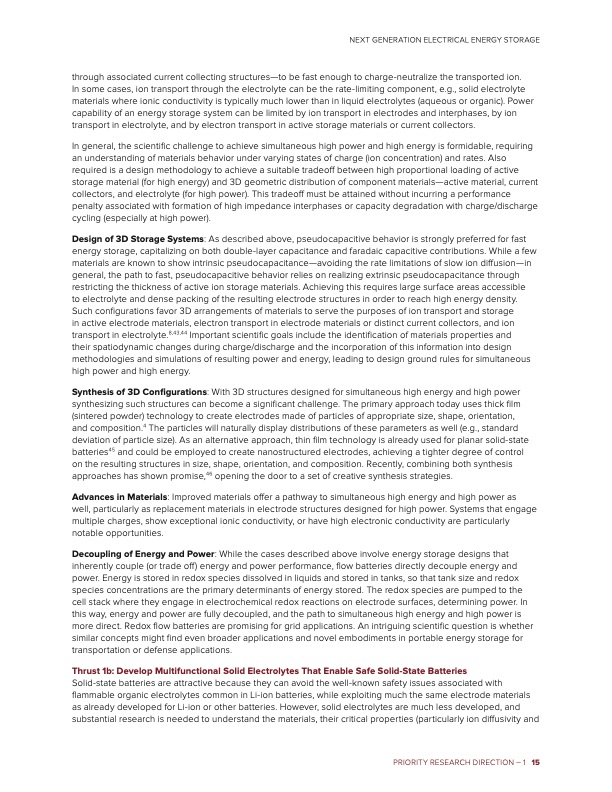
PDF Publication Title:
Text from PDF Page: 021
through associated current collecting structures—to be fast enough to charge-neutralize the transported ion. In some cases, ion transport through the electrolyte can be the rate-limiting component, e.g., solid electrolyte materials where ionic conductivity is typically much lower than in liquid electrolytes (aqueous or organic). Power capability of an energy storage system can be limited by ion transport in electrodes and interphases, by ion transport in electrolyte, and by electron transport in active storage materials or current collectors. In general, the scientific challenge to achieve simultaneous high power and high energy is formidable, requiring an understanding of materials behavior under varying states of charge (ion concentration) and rates. Also required is a design methodology to achieve a suitable tradeoff between high proportional loading of active storage material (for high energy) and 3D geometric distribution of component materials—active material, current collectors, and electrolyte (for high power). This tradeoff must be attained without incurring a performance penalty associated with formation of high impedance interphases or capacity degradation with charge/discharge cycling (especially at high power). Design of 3D Storage Systems: As described above, pseudocapacitive behavior is strongly preferred for fast energy storage, capitalizing on both double-layer capacitance and faradaic capacitive contributions. While a few materials are known to show intrinsic pseudocapacitance—avoiding the rate limitations of slow ion diffusion—in general, the path to fast, pseudocapacitive behavior relies on realizing extrinsic pseudocapacitance through restricting the thickness of active ion storage materials. Achieving this requires large surface areas accessible to electrolyte and dense packing of the resulting electrode structures in order to reach high energy density. Such configurations favor 3D arrangements of materials to serve the purposes of ion transport and storage in active electrode materials, electron transport in electrode materials or distinct current collectors, and ion transport in electrolyte.8,43,44 Important scientific goals include the identification of materials properties and their spatiodynamic changes during charge/discharge and the incorporation of this information into design methodologies and simulations of resulting power and energy, leading to design ground rules for simultaneous high power and high energy. Synthesis of 3D Configurations: With 3D structures designed for simultaneous high energy and high power synthesizing such structures can become a significant challenge. The primary approach today uses thick film (sintered powder) technology to create electrodes made of particles of appropriate size, shape, orientation, and composition.4 The particles will naturally display distributions of these parameters as well (e.g., standard deviation of particle size). As an alternative approach, thin film technology is already used for planar solid-state batteries45 and could be employed to create nanostructured electrodes, achieving a tighter degree of control on the resulting structures in size, shape, orientation, and composition. Recently, combining both synthesis approaches has shown promise,46 opening the door to a set of creative synthesis strategies. Advances in Materials: Improved materials offer a pathway to simultaneous high energy and high power as well, particularly as replacement materials in electrode structures designed for high power. Systems that engage multiple charges, show exceptional ionic conductivity, or have high electronic conductivity are particularly notable opportunities. Decoupling of Energy and Power: While the cases described above involve energy storage designs that inherently couple (or trade off) energy and power performance, flow batteries directly decouple energy and power. Energy is stored in redox species dissolved in liquids and stored in tanks, so that tank size and redox species concentrations are the primary determinants of energy stored. The redox species are pumped to the cell stack where they engage in electrochemical redox reactions on electrode surfaces, determining power. In this way, energy and power are fully decoupled, and the path to simultaneous high energy and high power is more direct. Redox flow batteries are promising for grid applications. An intriguing scientific question is whether similar concepts might find even broader applications and novel embodiments in portable energy storage for transportation or defense applications. Thrust 1b: Develop Multifunctional Solid Electrolytes That Enable Safe Solid-State Batteries Solid-state batteries are attractive because they can avoid the well-known safety issues associated with flammable organic electrolytes common in Li-ion batteries, while exploiting much the same electrode materials as already developed for Li-ion or other batteries. However, solid electrolytes are much less developed, and substantial research is needed to understand the materials, their critical properties (particularly ion diffusivity and NEXT GENERATION ELECTRICAL ENERGY STORAGE PRIORITY RESEARCH DIRECTION – 1 15PDF Image | Next Generation Electrical Energy Storage

PDF Search Title:
Next Generation Electrical Energy StorageOriginal File Name Searched:
BRN-NGEES_rpt-low-res.pdfDIY PDF Search: Google It | Yahoo | Bing
Sulfur Deposition on Carbon Nanofibers using Supercritical CO2 Sulfur Deposition on Carbon Nanofibers using Supercritical CO2. Gamma sulfur also known as mother of pearl sulfur and nacreous sulfur... More Info
CO2 Organic Rankine Cycle Experimenter Platform The supercritical CO2 phase change system is both a heat pump and organic rankine cycle which can be used for those purposes and as a supercritical extractor for advanced subcritical and supercritical extraction technology. Uses include producing nanoparticles, precious metal CO2 extraction, lithium battery recycling, and other applications... More Info
| CONTACT TEL: 608-238-6001 Email: greg@infinityturbine.com | RSS | AMP |